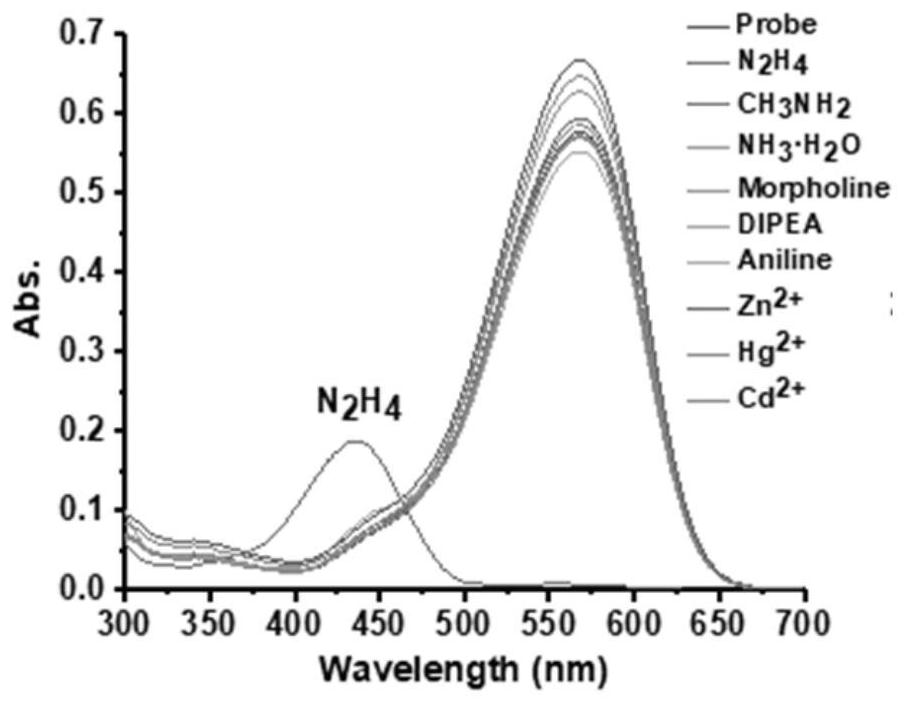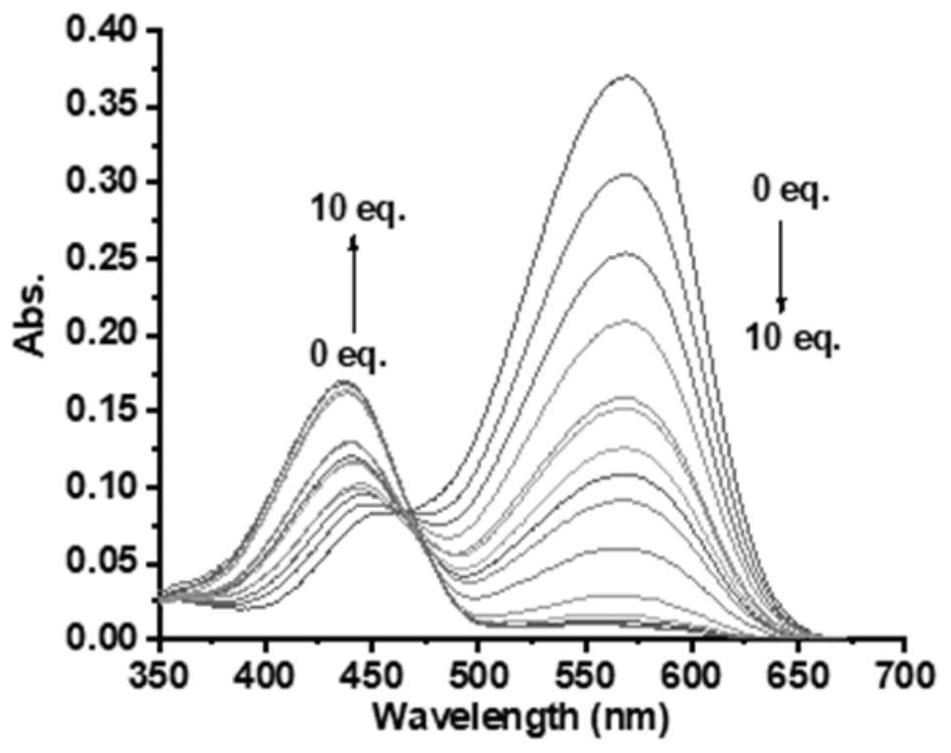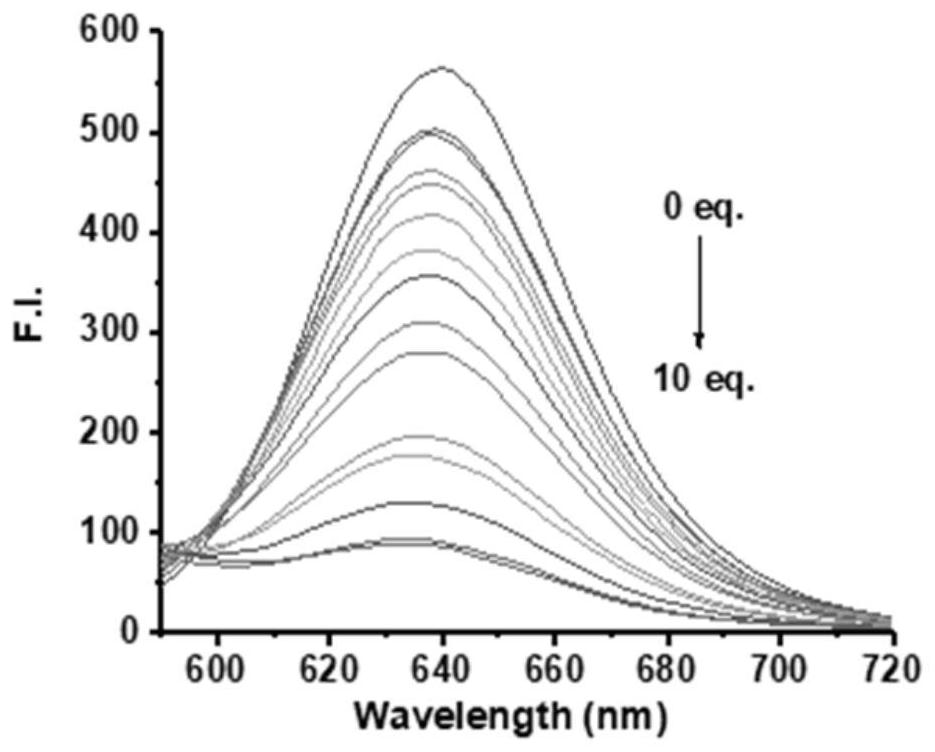A water-soluble ratiometric fluorescent probe for detecting hydrazine hydrate
A technology of fluorescent probes and hydrazine hydrate, which is applied in the direction of fluorescence/phosphorescence, luminescent materials, measuring devices, etc., can solve the problems of no mention of selectivity, single fluorescence response mode, and difficulty in realizing pure water phase detection, so as to reduce organic The effect of solvent participation, good fluorescence and UV selectivity, and good biological application prospects
- Summary
- Abstract
- Description
- Claims
- Application Information
AI Technical Summary
Problems solved by technology
Method used
Image
Examples
Embodiment 1
[0027] Synthesis and structural characterization of embodiment 1 probe
[0028] The substituted o-hydroxybenzaldehyde is used as the starting material, and the target product is finally obtained through cyclization reaction, decarboxylation reaction, Wilsmeyer-Hacker reaction and condensation reaction.
[0029] The synthetic probe route of the probe is as follows:
[0030]
[0031] Synthetic steps:
[0032] (1) References for the preparation of compounds 1, 2, and 3 (Chem. Commun. 2016, 52, 8675-8678).
[0033] (2) Preparation of Compound 4: Dissolve Compound 3 (6mmol, 1.48g) and 4-pyridineacetonitrile (7mmol, 0.83g) in 20mL of absolute ethanol, then add 10 drops of piperidine; the reaction system was stirred at 60°C After 6 hours, the heating was stopped, and it was naturally cooled to room temperature. The precipitated solid was filtered under reduced pressure and dried to obtain 1.43 g of compound 4 as a brown solid, with a yield of 68%. Due to the poor solubility of...
Embodiment 2
[0041] The impact of embodiment 2 probes on the ultraviolet absorption of hydrazine hydrate
[0042] 1. If figure 1 Shown, in 10mM, the PBS buffer solution that pH is 7.4, the ultraviolet absorption of probe (10μM) itself is at 560nm place, after adding 100μM (10 equivalents) hydrazine hydrate, the ultraviolet absorption peak that is positioned at 560nm place obviously reduces, and the new absorption A peak is generated at 450nm. Other types of amines (including methylamine, ammonia, morpholine, N,N-diisopropylethylamine, and aniline) and metal ions (zinc, mercury, and cadmium ions) do not produce UV responses.
[0043] 2. If figure 2 As shown, as the concentration of hydrazine hydrate increases (0-100 μM), the ultraviolet absorption peak at 560 nm gradually decreases, and the ultraviolet absorption peak at 450 nm gradually increases.
[0044] 3. If image 3 As shown, the probe has an excitation wavelength of hydrazine hydrate at 560nm, and the fluorescence emission wavel...
Embodiment 3
[0052] Embodiment 3 probe is to the detection of hydrazine vapor
[0053] Soak 20μL of the probe (1mM) solution in a round filter paper, put it in a fume hood to dry naturally, and put it into a 10mL sample bottle cap, which contains air, water, 0.1%, 1% and 5% respectively hydrazine hydrate solution with a concentration of 1mL, put the lid on and let stand for 20min. Such as Figure 8 As shown, the test paper in contact with air and water vapor has no color change and fluorescence response. After contacting with hydrazine vapor, the color of the test paper gradually changes from dark red to yellow with the increase of the solubility of hydrazine vapor. Under the light, the fluorescence gradually changes to green light.
PUM
 Login to View More
Login to View More Abstract
Description
Claims
Application Information
 Login to View More
Login to View More - R&D
- Intellectual Property
- Life Sciences
- Materials
- Tech Scout
- Unparalleled Data Quality
- Higher Quality Content
- 60% Fewer Hallucinations
Browse by: Latest US Patents, China's latest patents, Technical Efficacy Thesaurus, Application Domain, Technology Topic, Popular Technical Reports.
© 2025 PatSnap. All rights reserved.Legal|Privacy policy|Modern Slavery Act Transparency Statement|Sitemap|About US| Contact US: help@patsnap.com



